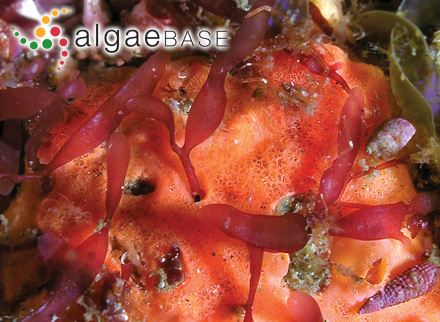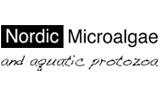Schottera nicaeensis (Duby) Guiry & Hollenberg 1975

Current name:
Schottera nicaeensis (Duby) Guiry & Hollenberg
KwaZulu-Natal; ramifying in a spongeTom Schils (tom@schils.be)
Publication Details
Schottera nicaeensis (Duby) Guiry & Hollenberg 1975: 153, figs 4-9, 11-15
Published in: Guiry, M.D. & Hollenberg, G.J. (1975). Schottera gen. nov. and Schottera nicaeensis (Lamour. ex Duby) comb. nov. (=Petroglossum nicaeense (Lamour. ex Duby) Schotter) in the British Isles. British Phycological Journal 10: 149-164, 15 figs.
Type Species
This is the type species (holotype) of the genus Schottera.
Status of Name
This name is of an entity that is currently accepted taxonomically.
Basionym
Halymenia nicaeensis J.V.Lamouroux ex Duby
Type Information
Type locality: Marseilles, France; (Silva & al. 1996: 319) Lectotype: STR; (Guiry & Hollenberg 1975: fig. 4) Notes: See also Dixon & Irvine (1977: 230). This type locality was first recorded by Guiry & Hollenberg (1975: 153).
General Environment
This is a marine species.
Description
Cartilaginous, thin, bright red fronds, flattened, to 80 mm high, slender cylindrical stipe to 5 mm long arising from rhizoids. Lamina simple, or once or twice dichotomous, strap-shaped, margins slightly ruffled. Apices rounded at first, later prolonged into long slender proccesses which may become attached to substratum and produce new erect shoots.
Habitat
Epilithic, lower littoral in pools and emergent, sublittoral to 15 m (Dixon & Irvine 1977: 231).
On rock in light-shaded pools, lower intertidal, southern and western coasts to Isle of Man and Northern Ireland; probably much under-recorded.
Similar Species
Phyllophora crispa, Stenogramme interrupta and Rhodymenia spp.
Created: 31 March 1996 by M.D. Guiry.
Last updated: 23 July 2022
Verification of Data
Users are responsible for verifying the accuracy of information before use, as noted on the website Content page.
Nomenclatural note
Professor Giovanni Furnari (e-mail, 10 December 2010) writes: "...let me disagree with the use of the diaeresis in the specific name "nicaeënsis". In fact, in classical latin the diaeresis indicates that a vocal should be pronounced separately from the preceding vowel, but is never used, since unnecessary, when a vowel is preceded by a diphthong. In the case of "nicaeensis", the second "e" cannot be linked in any case to the preceding "e" that is a part of the diphthong "ae" and consequently its pronounce is separated from the sound of the preceding diphthong "ae". Moreover, it should be noted that the diaeresis was not used by Duby i describing his Halymenia nicaeensis, and that it is not present in classical Latin dictionaries where the the adjective "nicaeensis" (from Nice) is
written without diaeresis." - (10 December 2010) - M.D. Guiry
Distributional note
Probable adventive species found on Australian coasts (Womersley 2003: 500). - (19 February 2009) - G.M. Guiry
Linking to this page: https://www.algaebase.org/search/species/detail/?species_id=125
Citing AlgaeBase
Cite this record as:
E.A. Molinari Novoa in Guiry, M.D. & Guiry, G.M. 23 July 2022. AlgaeBase. World-wide electronic publication, National University of Ireland, Galway. https://www.algaebase.org; searched on 29 March 2025
 Request PDF
Request PDF














